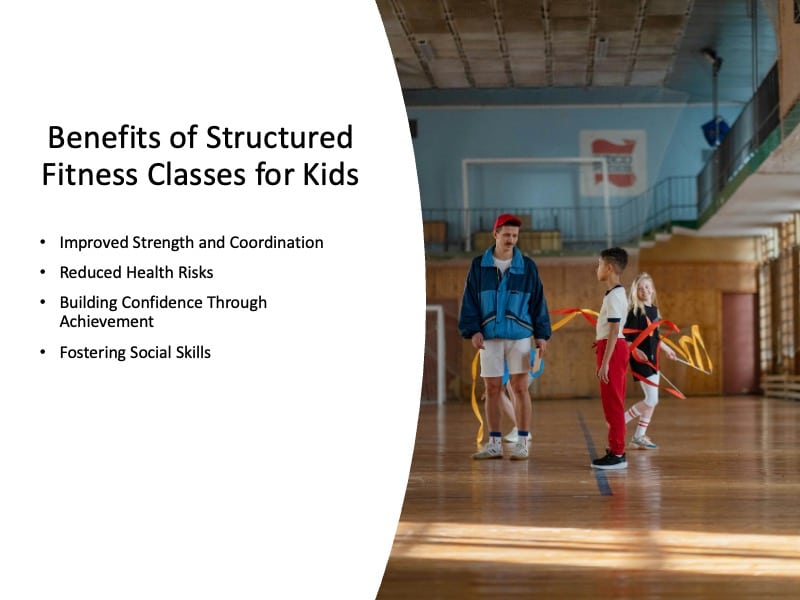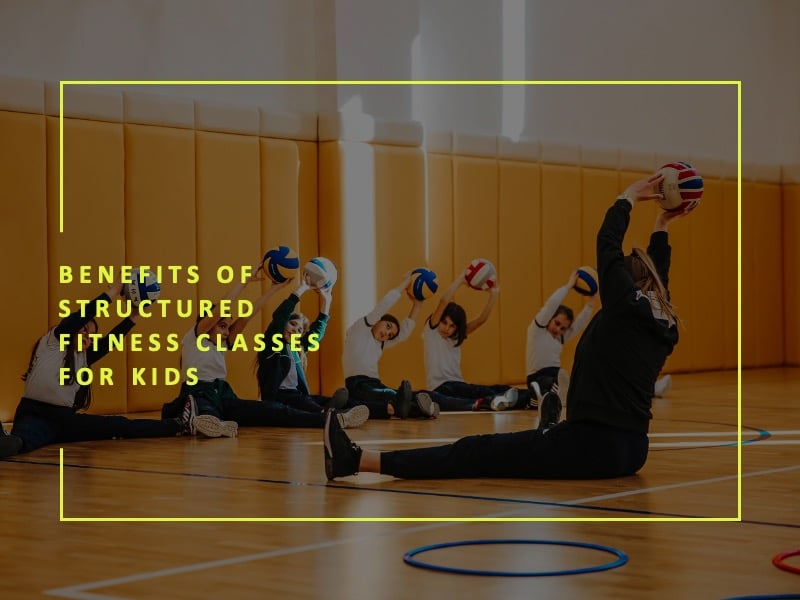Benefits of Structured Fitness Classes for Kids
In a world dominated by screens, structured fitness classes for kids are emerging as a powerful tool to combat sedentary lifestyles and promote overall well-being. These classes offer more than just physical activity; they’re a gateway to a lifetime of health, confidence, and social skills.
From martial arts to dance, gymnastics to team sports, structured fitness programs are tailored to capture young imaginations while building strong bodies and minds.
They provide a perfect blend of enjoyment and exercise, ensuring that kids associate physical activity with positive experiences.
As parents, we’re always on the lookout for ways to give our children the best start in life.
Structured fitness classes tick all the boxes – they encourage regular exercise, teach valuable life skills, and create opportunities for friendships.
But the benefits don’t stop there. These programs can significantly impact a child’s physical development, mental health, and social abilities, setting them up for success in all areas of life.
Let’s get moving and discover how these classes can transform your child’s health and happiness!
Physical Health Benefits
Structured fitness classes for kids offer a wealth of physical health benefits that are crucial for growing bodies.
Youth fitness programs are designed to address the unique needs of children, promoting healthy development and laying the foundation for a lifetime of wellness.
Let’s explore how these fitness programs for youth contribute to improved strength, coordination, and overall health.
Improved Strength and Coordination
One of the primary advantages of structured fitness classes is the significant improvement in strength and coordination, as structured multisport programs can lead to sustained improvements in physical fitness in healthy 5-to-6-year-old children.
This finding underscores the importance of introducing diverse physical activities early in a child’s life.
These programs often include exercises that target different muscle groups, helping kids build overall body strength.
Activities like bodyweight exercises, resistance training with light weights, and obstacle courses can contribute to muscular development in a safe, age-appropriate manner.
As children grow stronger, they become more capable in their daily activities and better prepared for various sports and physical challenges.
Additionally, coordination is another crucial aspect that benefits from structured fitness classes.
Through activities that require balance, agility, and precise movements, children develop better body awareness and motor skills.
This improved coordination enhances their sports performance and contributes to better posture, reduced risk of injury, and increased confidence in physical activities.
Reduced Health Risks
In an era of rising childhood obesity and related health issues, structured fitness programs play a vital role in reducing kids’ health risks. Regular participation in these classes can help maintain a healthy weight, improve cardiovascular health, and boost overall fitness levels.
School-based physical activity interventions may improve physical fitness, such as maximal oxygen uptake (VO₂max), but have little to no impact on body mass index. This highlights the importance of combining structured fitness programs with proper nutrition for optimal health outcomes.
While these classes may not directly lead to weight loss, they significantly improve cardiovascular fitness, which is crucial for long-term health.
Engaging in regular physical activity from a young age helps children develop lifelong healthy habits and reduces the risk of chronic diseases.
Youth fitness programs also educate children about the importance of staying active and making healthy choices, providing a solid foundation for physical wellness.
Mental and Social Benefits
While the physical benefits of youth fitness programs are evident, the mental and social advantages are equally significant.
Fitness programs for youth offer a unique platform for personal growth, emotional development, and social interaction.
Let’s look at how these structured activities contribute to building confidence and fostering essential social skills.
Building Confidence Through Achievement
Structured fitness classes provide children with numerous opportunities to set goals, overcome challenges, and experience the thrill of achievement.
As kids master new skills, whether it’s perfecting a dance routine or improving their running time, they gain a sense of accomplishment that boosts their self-esteem.
This increased confidence often extends beyond the fitness class.
Physically active children tend to have better grades, better school attendance, better cognitive performance, and better classroom behaviors, as there is a positive relationship between sports and academic performance.
The self-assurance gained from conquering physical challenges can translate into academic settings, encouraging children to tackle new subjects with enthusiasm and perseverance.
Moreover, the structured nature of these programs teaches kids the value of practice and dedication. As they witness their progress over time, they develop a growth mindset – understanding that abilities can be developed through effort and persistence.
This mindset is invaluable not just in fitness but in all areas of life.
Fostering Social Skills
Youth fitness programs provide a structured, goal-oriented setting where kids learn social skills through cooperation, communication, and support of others.
These interactions can benefit children who struggle in traditional social situations.
Higher physical activity levels are linked to improved cognitive performance, which can help kids navigate social situations more effectively.
Programs like team-based fitness classes also offer opportunities for kids to interact with positive adult role models, fostering confidence, goal-setting, and crucial social skills.
How to Find the Right Fitness Program for Your Child

Selecting the ideal youth fitness program for your child is a crucial decision that can shape their attitude towards physical activity for years to come.
With the right approach, you can ensure that your child not only reaps the health benefits but also develops a lifelong love for fitness.
Let’s explore how to strike the perfect balance and focus on skills that promote long-term growth.
Find a Balance of Fun and Structure
The key to a successful fitness program for youth lies in finding the sweet spot between enjoyment and structured learning.
Preschool children are sedentary for almost 50% of their time at childcare, highlighting the need for structured physical activity programs.
This statistic underscores the importance of introducing structured physical activities early on. However, it’s equally crucial that these activities are fun and engaging to keep children motivated.
When evaluating youth fitness programs, look for those that incorporate elements of play and creativity alongside structured exercises.
Programs that use games, challenges, and varied activities tend to keep children more engaged than those focusing solely on repetitive exercises.
For instance, a program that turns strength training into a treasure hunt or cardio exercises into a dance party is likely to be more appealing to kids.
Consider your child’s interests and personality when choosing a program. If your child loves music, a dance-based fitness class might be ideal.
For those who enjoy competition, team sports or martial arts could be a great fit.
The goal is to find a program where your child looks forward to participating rather than viewing it as a chore!
Focus on Skills That Support Long-Term Growth
While immediate fun is important, it’s equally crucial to choose a fitness program that builds skills for long-term physical development. Look for programs that focus on fundamental movement skills such as balance, coordination, agility, and strength.
These foundational skills will serve your child well in any future physical activities or sports they might pursue.
Only about 4% of the nation’s schools offer daily physical education, while 20% of schools provide no physical education at all.
Given this lack of consistent physical education in schools, it’s even more important to choose a youth fitness program that offers comprehensive physical development.
When looking for youth fitness programs, consider those that offer a variety of activities, emphasize proper form and technique, incorporate goal-setting and progress tracking, and balance fun with structure.
Remember, the best program is one that your child enjoys and wants to continue participating in, fostering a positive relationship with physical activity!
Final Thoughts: Should Your Child Do Structure Fitness Classes?
Structured fitness classes for kids offer a multifaceted approach to physical, mental, and social development, setting children on a path to lifelong health and wellness.
They help children improve physical fitness, gain valuable life skills, and develop healthy habits and a positive attitude towards physical activity.
Parents need to choose a program that balances fun with structure, offers a variety of activities, and focuses on long-term skill development.
Investing in structured fitness classes for your child is an investment in their future, equipping them with the tools they need to lead a healthy, confident, and fulfilling life.
Frequently Asked Questions by Parents
- At what age should my child start structured fitness classes? Children can start as early as 3-4 years old with age-appropriate programs. However, the best age to start depends on your child’s individual development and interests.
- How often should my child attend these classes? Most experts recommend that children get at least 60 minutes of physical activity daily. Structured classes two to three times a week, combined with free play and other activities, can help meet this goal.
- Will structured fitness classes interfere with my child’s growth? When done correctly, these classes support healthy growth and development. Reputable programs are designed with children’s physiological needs in mind.
- What if my child isn’t naturally athletic? Structured fitness classes are beneficial for all children, regardless of natural ability. They focus on individual progress and can help less athletic children build confidence and skills.
- How can I support my child’s fitness journey at home? Encourage active play, limit screen time, and model healthy habits yourself. Many programs offer suggestions for at-home activities to complement their classes.
- Are these classes safe for children with health conditions or disabilities? Many programs can accommodate children with various needs. Always consult with your child’s healthcare provider and the program instructors to ensure safety.
- How do I know if a program is high-quality? Look for qualified instructors, age-appropriate activities, a focus on fun and skill development, and positive reviews from other parents.
- Will these classes help my child in school? Research suggests that regular physical activity can improve cognitive function, concentration, and behavior in school.
- How long before I see results in my child’s fitness? Every child is different, but many parents report seeing improvements in strength, coordination, and confidence within a few weeks to a few months.
- What if my child wants to quit? Try to understand why. Sometimes, switching to a different type of program or addressing specific concerns can reignite their interest. Remember, the goal is to foster a lifelong love of physical activity.
Read Next: Top 10 Health & Fitness Tips for Children



